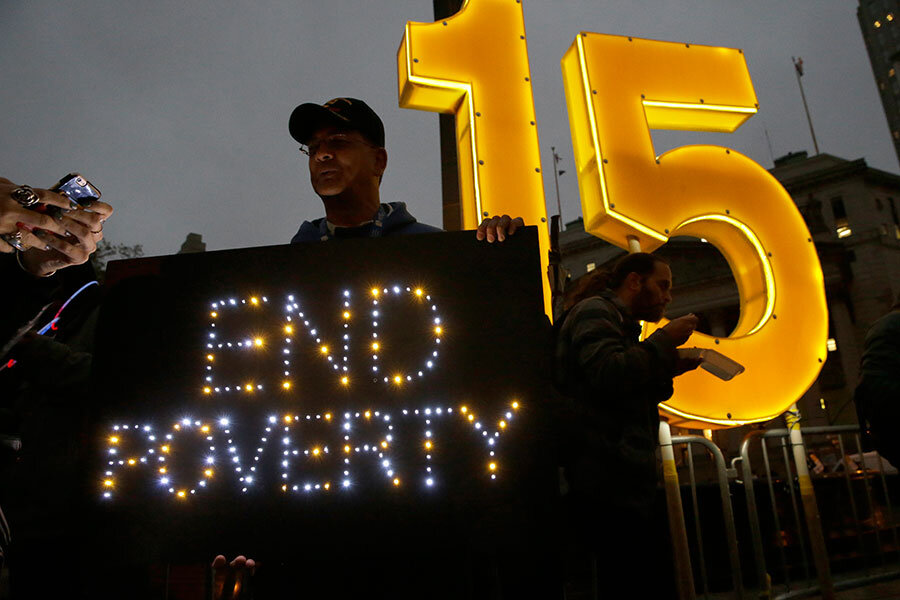How $15 minimum wage fight became a juggernaut in three years
Loading...
Three years ago this month about 200 fast-food workers in New York City walked off the job in protest of low wages and poor working conditions.
The New York Times described the protest as "by far the largest series of job actions at fast-food restaurants ever" and "part of an ambitious plan that seeks to unionize workers and increase wages at fast-food restaurants across the city."
Three years later, that movement, now known as "Fight for $15," is no longer confined to New York or protesters numbering in the hundreds. Thousands of protesters in some 270 cities across the country took to the streets earlier this week. On Thursday, in what is being dubbed a Million Student March, students across the country were set to stage a walkout protesting student debt and demanding a $15 an hour minimum wage for campus workers.
What was once a fringe campaign is now a major election issue – as evidenced by the fact that it was the first topic discussed at the Republican presidential debate Tuesday night.
Today, the minimum wage fight has come to encapsulate a growing national angst over income that goes far beyond the millions of Americans at the lowest end of the pay scale.
The 2011 Occupy movement and its condemnation of "the 1 percent" drew national attention to growing income inequality in America. Since then, some data suggest that the problem has only gotten worse. A study last year reported that economic inequality in the United States had reached levels not seen since the Great Depression.
The push for a higher minimum wage appears to be capitalizing on that trend by unifying more Americans who are seeing their dollars not stretching as far as they used to.
"Over the last decade or more, the middle class, working families, and working adults are finding it harder and harder to get by," says Barry Bluestone, director of the Dukakis Center for Urban and Regional Policy at Northeastern University in Boston.
"I think we’re starting to get solidarity," he adds. "Many people are joining this movement even though they're paid well above the minimum wage."
Until recently, Congress typically rubber-stamped federal minimum wage increases, notes Elizabeth Ananat, a visiting fellow at Northwestern University’s Institute for Policy Research and an associate professor of economics at Duke University. Since 2009, the wage has stayed at $7.25.
"There's been a longer period of [government] not responding," she says. "I think that's led to a louder and stronger protest movement."
The growth of the movement to raise the minimum wage to $15 has surprised even some of its organizers. But experts say the success isn’t all that surprising given some of the organizing strategies and the overall economic climate of the country.
On top of a general anxiety over low wages, Fight for $15’s rise has been powered by its poster children: fast-food workers, 96 percent of whom make less than $15 an hour, according to the National Employment Law Project (NELP).
"They’re a very visible [group] of low-wage workers," says Dr. Ananat. "A lot of people consume fast-food, so they see these folks a lot."
"It's put a face on who the low-wage workforce is in this country," adds Tsedeye Gebreselassie, a senior staff attorney for NELP, "and they're not teenagers doing this for extra pocket money, they’re adults."
As more low-wage workers have flocked to the cause – including retail workers, home-care, and child-care workers – cities and states around the country have been responding. Seattle, San Francisco, and Los Angeles have approved minimum wage increases to $15 – though some won’t reach $15 for several years – while several states have enacted measures raising their minimum wage above the federal government’s, including Republican-leaning states such as Alaska and South Dakota.
Politicians have taken to these policy changes with greater confidence because of a growing academic consensus over the potential impacts of a minimum wage increase, says Dr. Bluestone.
"There's an economic argument against raising the minimum wage that has been made time and time again that if we raise minimum wage firms will lay off employees," he says. "There's a ton of research suggesting that doesn’t happen."
Indeed, Bluestone was one of more than 600 economists who signed a letter to leading federal politicians, including President Obama, supporting an increase in the federal minimum wage to $10.10.
Still, there is not unanimity on the economic benefit of raising the minimum wage. Some studies continue to suggest it hurts the broader economy. Republicans in Congress have so far argued against efforts to raise the wage, citing the potential impact on businesses. But there are signs of potential movement. The "Raise the Wage Act" introduced in the Senate earlier this year proposes raising the wage to $12 an hour.
Raising the federal minimum wage may be the last, and most important, domino to fall, says Charles Betsey, an economics professor at Howard University, in an e-mail to the Monitor. An increase in the federal minimum wage, he says, "will have the most far-reaching effect economy-wide."








